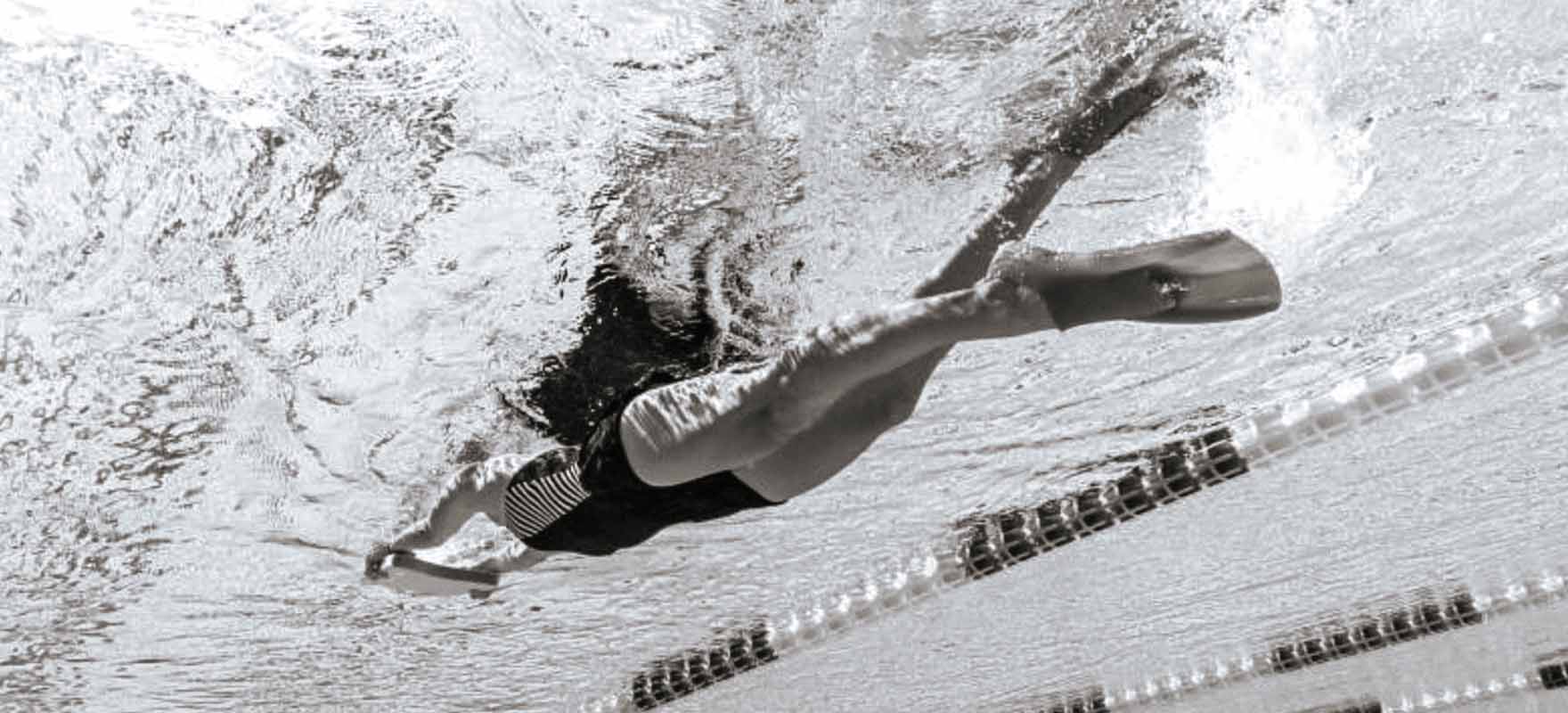Swimming With Fins: Workouts to Help You Get Faster and Stronger
Whether you’re a high-level swimmer or someone who’s newer to the sport, one thing’s for sure: swimming with fins during workouts is a great way to take your swimming skills to the next level.
But in order to get the most out of your fins, it’s important to understand how exactly they help, how to pick the right ones, and where to start when it comes to swimming with fins workouts.
In this article, you’ll learn everything you need to know to get started on swim fin training today.
What Are Swimming Fins?
In the simplest of terms, swimming fins are a piece of gear that you wear on your feet to help you move faster and more efficiently through the water.
Mimicking the fins that aquatic animals have by nature, swimming fins help humans to get more thrust from swimming kicks. Fins increase the surface area of your feet, adding resistance and providing you with better propulsion with which to move through the water.
Not to be confused with diving or snorkeling fins, swim fins for pool workouts are much smaller in size and have different rigidity and shape qualities compared to other types of swimming activity fins on the market.
Why Should You Use Swimming Fins?
If you’re training to improve your swimming, incorporating fins into your workouts helps you get stronger and practice better overall technique.
Swimming Faster
Here’s the thing: of course swimming with fins makes you faster while you’re using them, but it also makes you faster without them.
This happens because fins add resistance to your up-kick, in turn strengthening your hamstrings, glutes, and lower back muscles.
Swimming with fins also helps increase flexibility in your ankles which is another crucial component in your ability to create a powerful kick.
Improving Your Swimming Technique
Another big piece of mastering great swimming technique is the ability to keep your legs higher in the water. Fins help you do this by generating greater power and propulsion from your lower body and driving your feet toward the surface. This, in turn, helps you practice maintaining your body positioning at the water’s surface for a more streamlined stroke.
Swimming with fins also helps improve your kicking form because they naturally encourage you to kick from your hips rather than from your knees and to kick more narrowly and consistently, in turn reducing the resistance and drag your body experiences when moving through the water.
Burning More Calories
Given the added resistance that fins put on your kick and the subsequent increase in muscular output required to overcome it, swimming with fins helps you burn more calories by making some of the largest muscles in your body work even harder.
Giving Your Upper Body a Breather
Many swimmers, especially triathletes, focus on strengthening their upper body and using it as the driving force behind their swimming stroke.
And while a strong upper body is critical for becoming a stronger and faster swimmer, it’s also possible to overexert your shoulders, arms, chest, and back.
When you practice swimming with fins in your workouts, you’re able to continue swimming and building your fitness while giving your upper-body a much-needed rest.
Over time, this also allows your legs to take on a bit more of the burden without burning them out.
Making Your Drills More Effective
When you’re working on becoming a faster and stronger swimmer, doing swim drills is one of the most important tools in your toolbox.
On a fundamental level, swimming drills are a set of motions that focus on particular strokes, swim skills, or muscle groups.
They’re designed to break down your strokes and skills into individual components which you can target and improve to create a better holistic result.
And that’s why fins are such a crucial component of these drills: many of them include fins in order to focus on strengthening your swim kicks or making them more efficient, helping you propel yourself through the water more quickly.
But fins aren't always about going faster. They also help you maintain your stroke and your positioning in the water with much less effort from the arms and the legs. They allow you to slow down your stroke, focus less on the exertion of keeping your body afloat, and focus more on the technique that you’re trying to improve.
If you’d like to learn more about how to incorporate swim drills with fins into your swim training, read through our resource: How Swimming Drills Help You Get Faster, Stronger, and More Efficient.
Making Swimming More Fun
While this doesn’t necessarily contribute directly to strength or technique, swimming extra fast through the water is a fun and enjoyable experience—and fins help you do just that.
At the end of the day, enjoying the experience of swimming is one of the most important things. If you’re having fun, you’ll feel more motivated and inspired to put in the time, effort, and consistency needed to improve.
How to Pick the Right Swimming Fins for You
When you’re shopping for swim fins for pool workouts, a quick glance makes the decision feel simple. But there’s more to it than you might think, and picking the right fins is incredibly important.
Short vs. Long Blade Fins
Swimming fins with short blades promote a faster, more frequent kicking tempo, which is important for freestyle and backstroke training.
Long-blade swimming fins provide a greater range of motion and a higher level of resistance for a slower and more focused kick. You won’t be able to kick as fast as you would with short fins, but this can help build better leg strength.
Because of this, short-blade fins are ultimately better suited for experienced swimmers and long-blade fins are a better choice for beginner or intermediate athletes.
Rubber vs. Silicone
Traditionally, swimming fins were made with rubber, and one of the unwanted byproducts of this material was the fact that it’s prone to causing blisters.
Silicone is softer and, in turn, creates much less rubbing and friction on your feet.
Open vs. Closed Heel
If you’ve seen fins with both open and closed heels and found yourself wondering why, the answer is simple: closed-heel fins are more geared towards competitive swimmers whereas open-heeled fins are tailored for beginner and intermediate swimmers and will allow for a fuller range of motion.
Rigid vs. Flexible
Swimming fins vary quite a bit in terms of their rigidity.
Some fins are incredible stiff, which will make it harder to kick in them and provide you with a harder workout, as a result. They’ll also be a lot less forgiving on your feet than their softer counterparts.
Softer fins, on the other hand, will be easier to kick with and give your legs an easier workout.
If you’re a competitive swimmer, rigid fins might be right for you. But, if you’re building your swimming fitness and technique, less rigid fins will most likely provide you with a more comfortable swimming experience.
Finding the Right Fit
When you’re trying on fins, there are a few considerations to keep in mind:
- The heel of your fin should fit snugly but not tightly
- Make sure your heel doesn’t slide around in the fin because this can cause blisters
- On the other hand, make sure your heel isn’t too compressed or you can cut off circulation or cause foot cramps and discomfort
Pro tip: Try to avoid buying fins online, whenever possible. Getting hands-on with a pair of fins will let you assess whether they’re right for you before you actually make the purchase—and find yourself in discomfort in the pool.
2 Simple Swimming with Fins Workouts
If you want to start incorporating swimming with fins workouts into your training plan, here are a few options you can test out based on your level of experience.
Love My Fins (Low Technique)
Get comfortable with your fins in this 1,200-yard workout. Use your fins to improve your kick and body position. Change your kick tempo to change speeds.
Coach's Tip: When kicking, hold the board at the edge with arms extended, and kick with your head down in the water with a long neck. Always keep your fins mostly in the water for maximum propulsion.
Warm Up
- 1 x 100 Freestyle @ Easy + 20 seconds rest
- 2 x 50 Choice @ Easy + 20 seconds rest between intervals
- 45 seconds rest after set
Main Set
- 2 x 50 Freestyle Kick @ Moderate + 20 seconds rest between intervals (with kickboard and fins)
- 1 x 100 Freestyle @ Easy + 20 seconds rest (with fins)
- 2 x 50 Choice @ Moderate + 20 seconds rest between intervals
- 2 x 50 Freestyle Kick @ Moderate + 20 seconds rest between intervals (with kickboard and fins)>
- 1 x 100 Freestyle @ Moderate + 20 seconds rest (with fins)
- 2 x 50 Choice @ Moderate + 20 seconds rest between intervals
- 2 x Freestyle Kick @ Strong + 20 seconds rest between intervals (with kickboard and fins)
- 1 x 100 Freestyle @ Strong (with fins)
- 45 seconds rest after set
Warm Down
- 4 x 50 Choice @ Easy + 15 seconds rest between intervals
Fins for Any Speed (Moderate Sprint)
Turn up the tempo and swim at different speeds using your fins in this 1,400-yard workout. Use this pre-set to build your speed from slow to fast, find the right tempo to distinguish between easy to max speeds with your kick, and give this main set your all.
Coach’s Tip: Always keep your fins mostly in the water for maximum propulsion. Keep your kick narrow to change tempo more efficiently.
Warm Up
- 1 x 100 Choice @ Easy + 20 seconds rest
- 1 x 100 Freestyle @ Moderate
- 30 seconds rest after set
Pre-Set
- 2 x 50 Freestyle @ Build Strong-Fast + 20 seconds rest between intervals (with fins)
- 1 x 100 Freestyle @ Moderate
- 45 seconds rest after set
Main Set (2 rounds)
- 1 x 50 Freestyle @ Fast + 20 seconds rest (with fins)
- 1 x 100 Freestyle @ Easy + 30 seconds rest (with fins)
- 1 x 50 Freestyle @ Max + 20 seconds rest (with fins)
- 1 x 100 Freestyle @ Moderate + 20 seconds rest (with fins)
- 1 x 100 Choice @ Easy
- 30 seconds rest after set
Warm Down
- 1 x 200 Choice @ Easy
Learn to Master Swimming with Fins Workouts with FORM
If you’re looking to develop a stronger and more efficient swimming technique, fins workouts are a great thing to incorporate into your training plan. And FORM is here to help you through that process.
With FORM, you'll swim with real-time metrics right there in your goggles. Plus, get a free 1-year membership and boost improvement in the pool with 1,000+ workouts, 30+ training plans, and a custom workout builder.
Backed by a 2-year warranty and 30-day return guarantee, FORM goggles are built to last.
Already have FORM goggles, but don’t have access to our full range of features? Head to the FORM app to start a 30-day free membership trial*.
*30-day free membership trial is only valid for one-time use for new members who have previously purchased FORM goggles.










